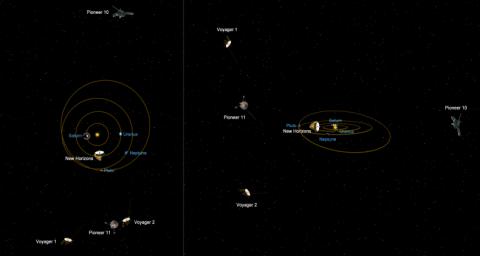
|
Relative Positions of Distant Spacecraft
- Click the image above for a larger view
- Full-Res JPEG (2160 x 1152) (111.1 kB)
- Full-Res TIFF (2160 x 1152) (7.5 MB)
Caption:
This graphic shows the relative positions of NASA's most distant spacecraft in early 2011, looking at the solar system from the side. Voyager 1 is the most distant spacecraft, about 17.5 billion kilometers (10.9 billion miles) away from the sun at a northward angle. Pioneer 10, the next most distant, is about 15.4 billion kilometers (9.6 billion miles) away from the sun on the opposite side of the solar system. Voyager 2 is about 14.2 billion kilometers (8.8 billion miles) away from the sun on a southward trajectory, on the same side of the solar system as Voyager 1. Pioneer 11 is about 12.4 billion kilometers (7.8 billion miles) away from the sun. New Horizons is about 3 billion kilometers (2 billion miles) away from the sun, on its way to Pluto.
Background Info:
The Voyagers were built by NASA's Jet Propulsion Laboratory in Pasadena, Calif., which continues to operate both spacecraft. JPL is a division of the California Institute of Technology in Pasadena. The Voyager missions are a part of the NASA Heliophysics System Observatory, sponsored by the Heliophysics Division of the Science Mission Directorate.
For more information about the Voyager spacecraft, visit http://www.nasa.gov/voyager and http://voyager.jpl.nasa.gov .
Cataloging Keywords:
| Name | Value | Additional Values |
|---|---|---|
| Target | Pluto | |
| System | Pluto | Kuiper Belt |
| Target Type | Dwarf Planet | KBO |
| Mission | Voyager | New Horizons, Pioneer |
| Instrument Host | Voyager 1 | New Horizons, Pioneer 10, Voyager 2 |
| Host Type | Flyby Spacecraft | |
| Instrument | ||
| Detector | ||
| Extra Keywords | Color | |
| Acquisition Date | ||
| Release Date | 2011-04-29 | |
| Date in Caption | ||
| Image Credit | NASA/JPL-Caltech | |
| Source | photojournal.jpl.nasa.gov/catalog/PIA14112 | |
| Identifier | PIA14112 | |
